The x86 Power Myth Busted: In-Depth Clover Trail Power Analysis
by Anand Lal Shimpi on December 24, 2012 5:00 PM ESTSunSpider 0.9.1
Now the fun stuff. Doing power profiles of our standard benchmarks gives us good insight into how well each vendor was able to balance peak performance and average power. In general it's ok to burn more power for a short amount of time as long as it means you'll get to sleep quicker. This was one of the fundamentals of the first transition to mobile from the early 2000s.
We already know that Intel completes SunSpider quicker thanks to its improved memory subsystem over the Cortex A9, but it also does so with much better average power (3.70W vs. 4.77W for this chart). A big part of the average power savings comes courtesy of what happens at the very tail end of this graph where the W510 is able to race to sleep quicker, and thus saves a good deal of power.
| JavaScript Performance | |||||||
| Time in ms (Lower is Better) | Kraken | SunSpider | RIA Bench Focus | ||||
| Acer W510 (Atom Z2760 1.8GHz) | 33220.9ms | 730.8ms | 3959ms | ||||
| Microsoft Surface (Tegra 3 1.3GHz) | 49595.5ms | 981.1ms | 5880ms | ||||
| Samsung ATIV Smart PC (Atom Z2760 1.8GHz) | 33406.0ms | 721.3ms | 3752ms | ||||
| Apple iPad 4 (A6X) | 19086.9ms | 834.7ms | - | ||||
| Google Nexus 10 (Exynos 5 Dual) | 11146.0ms | 1384.1ms | - | ||||
I also used SunSpider as an opportunity to validate the results from Intel's tablets with my own review samples. To generate this chart I measured power, every second, at the wall with both devices plugged in and with a fully charged battery. The resulting power consumption numbers include the efficiency loss at the AC adapter but the general curve shoud mimic the results above:
Note that the results do generally line up, although measuring at the battery gives more accurate results for the device and using the NI DAQ I was able to get better granularity on the power measurements.
Looking at CPU level power consumption we see a very even match between Atom and Tegra 3. Intel's advantage really comes from being able to complete the workload quicker (0.52W compared to 0.72W on average).
Once again we see a pretty significant difference in power consumption on the GPU rail between these two platforms.
Kraken
Mozilla's Kraken benchmark is a new addition to our js performance suite, and it's a beast. The test runs for much longer than SunSpider, but largely tells a similar story:
RIABench
RIABench's Focus Tests are on the other end of the spectrum, and take a matter of seconds to complete. What we get in turn is a more granular look at power consumption:




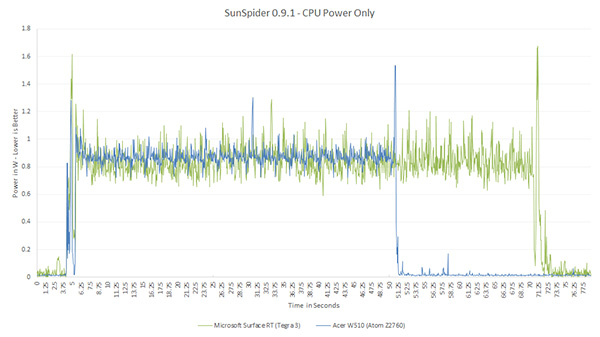

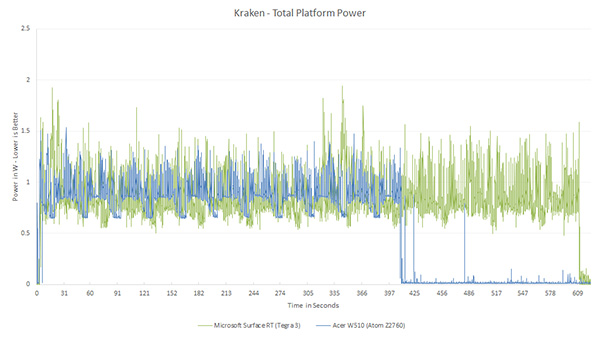
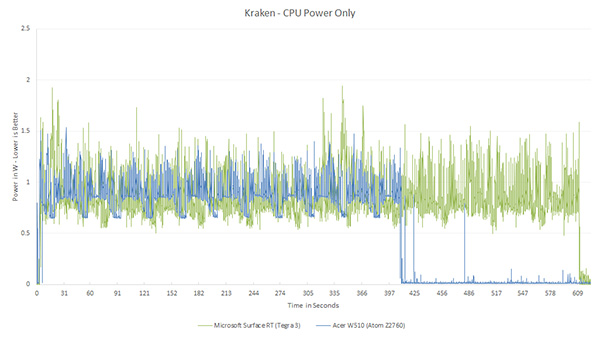

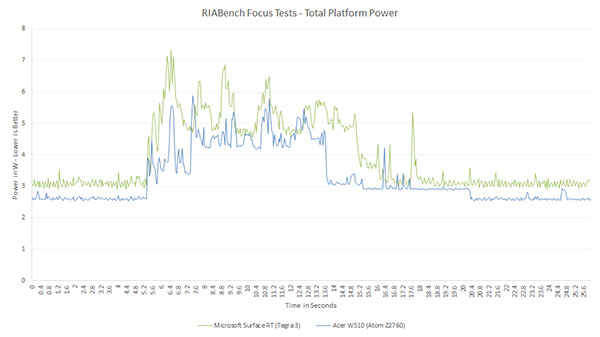
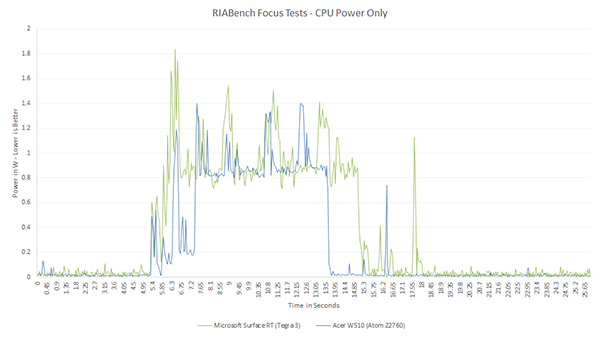
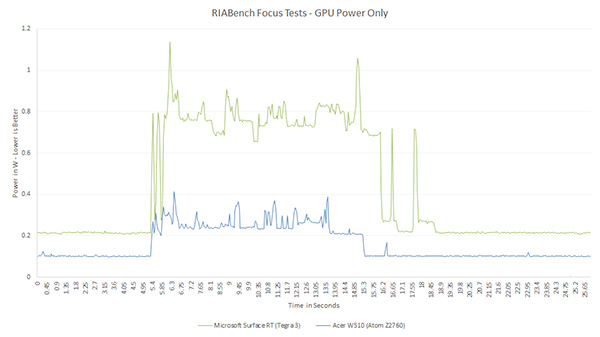








163 Comments
View All Comments
yyrkoon - Tuesday, December 25, 2012 - link
"The real deal will come with the complete new uArch for Atom and if they manage to "pull off a Core 2" again (which I believe) it won't look pretty for Team ARM."Maybe, but also keep in mind that android device sales have already eclipsed that of the x86 PC based market( in total numbers sold ). Which means things are not looking pretty for Intel already. Granted, it is a low cost market, which has less revenue potential.
"Core 2 based atom" would be pretty cool. If they managed to keep the performance up. We'll see how that works out. in a few years ( maybe ).
beginner99 - Tuesday, December 25, 2012 - link
I would say phones always outsold PC in the last decade ( I have no proof) but then they were just that phones with pathetic ARM cores. Now they are more like computers.I did not mean Core 2 based, but just shocking your competitors and basically making them irrelevant overnight. It's a new uArch that will be way better than current design.
http://www.anandtech.com/show/4333/intels-silvermo...
coolhund - Tuesday, December 25, 2012 - link
There have been reports before that stated the super duper uArch (OoO) would become reality with 32 nm Atoms, but it didnt. Now the same crap is assumed (!) again with the 22 nm ones.I dont believe it.
wsw1982 - Tuesday, December 25, 2012 - link
The different is assumed vs. official...coolhund - Wednesday, December 26, 2012 - link
Oh really?Show me that official statement then.
coolhund - Thursday, December 27, 2012 - link
Thought so.yyrkoon - Tuesday, December 25, 2012 - link
My conclusion that android device sales eclipsed that of the total x86 PC sales came from an Article in an embedded trade magazine. It does make sense however as well.Personally, I feel that Intel is going about the idea of Atom all wrong. Lower powered versions of the latest processors they have now would make more sense. Say another tier under their current mobile line. While perhaps re-tasking Atom to embedded duties.
As it stands now. Atom is a processor that can not make up it's mind what it wants to be. In a few ways it is competitive, but in terms of cost it has a ways to go yet.
coolhund - Wednesday, December 26, 2012 - link
Well at least they are trying ULV versions now of Sandy and Ivy Bridge.IMO the much better way to go.
InsGadget - Sunday, January 6, 2013 - link
Your conclusion concerning Android vs PC sales is wrong. While Android is approaching (and perhaps, this year, surpassing) total PC sales per year, more PCs are sold right now than Androids. Source: http://thenextweb.com/google/2012/01/16/its-a-mobi...Exodite - Tuesday, December 25, 2012 - link
The iPhone 5 review contains some nice tables that includes both the Motorola RAZR M and Motorola RAZR i, even then the general performance category favors the RAZR i.Battery life is a more difficult proposition, as the RAZR M has LTE while the RAZR i does not.
Still, the A15 will make for a interesting comparison when available. Both for Intel as well as Qualcomm's Krait-based SoCs.